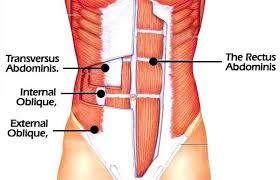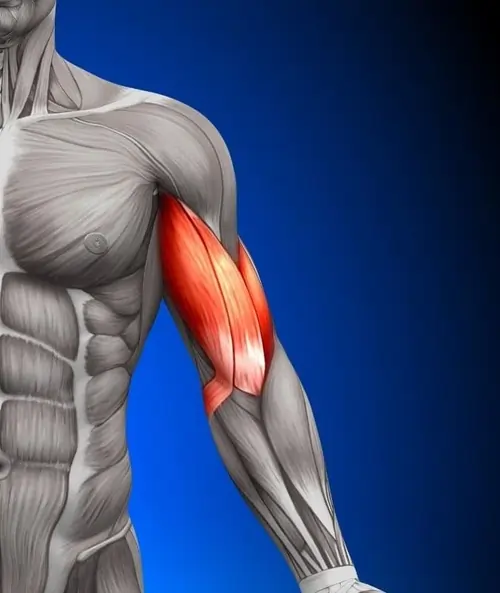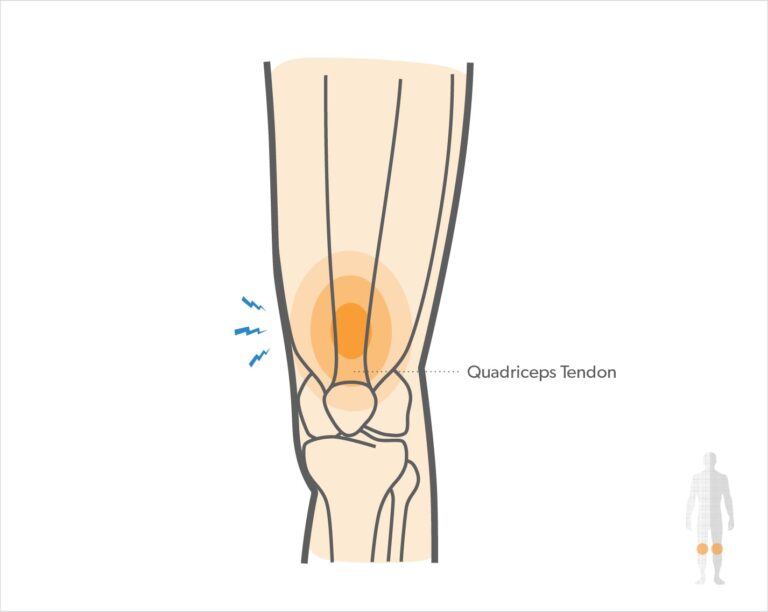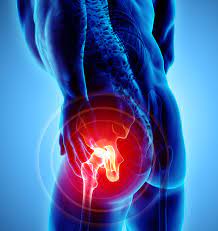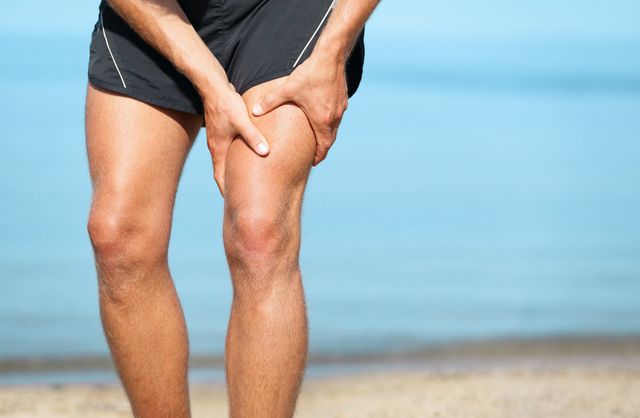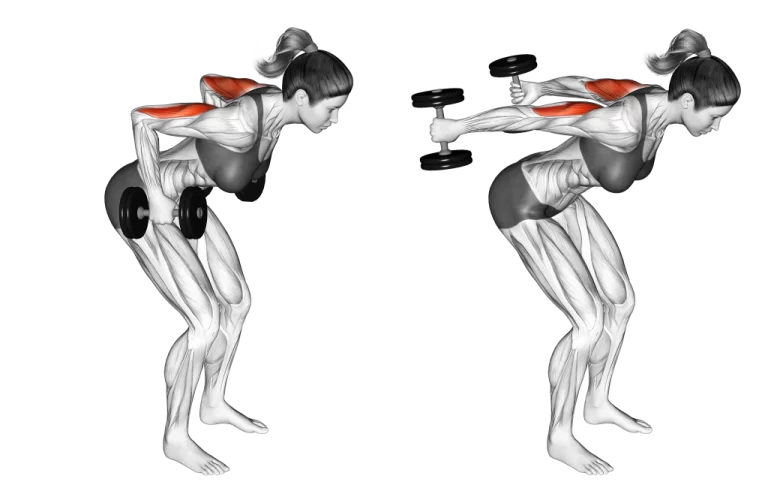Abdominal Muscle Pain
Table of Contents
What is the abdominal muscle pain?
An abdominal muscle pain refers to pain in the stomach. It is often an overuse injury. A stretching or tearing of an abdominal muscle or a tissue connecting muscle to bone (tendon) may also cause abdominal muscle pain. It can be occur due to many reasons like gas, indigestion, pulled or muscle strain of the abdomen, etc.
A abdominal muscle pain can make the abdomen feel sore & tender, especially during movement. If people have pulled a muscle, they may notice the following symptoms in & around the abdomen: soreness or tenderness. pain or discomfort when touching the abdomen. As sometimes it can be healed by self without requiring any treatment, just by doing proper rest or care but sometimes depending upon severity it required proper treatment & care.
What are the abdominal muscles?
The abdominal muscles are the muscles forming the abdominal walls & the abdomen is the portion of the trunk connecting the thorax & pelvis. An abdominal wall is formed of skin, fascia, & muscle & encases the abdominal cavity & viscera.
The abdominal muscles support the trunk, allow movement, hold organs in place & are extensible (being able to accommodate dynamic changes in the volume of abdominal contents).
There are five main muscles in the abdomen:
External obliques.
Internal obliques.
Pyramidal.
Rectus abdominal.
Transverses abdominal.
Where are the abdominal muscles located?
There are five main muscles in the abdomen. Two are vertical (up & down) muscles located toward the middle of the body. Three are flat muscles stacked on top of the each other, located toward the sides of the trunk.
The two vertical muscles are the:
Pyramidal: This vertical muscle is small & shaped like a triangle. It’s located very low, in the pelvis. It helps maintain internal pressure in the abdomen.
Rectus abdominal: This pair of muscles goes down the middle of the abdomen from the ribs to the front of the pelvis. The muscles hold the internal organs in place & keep the body stable during movement. The rectus abdominal may form bumps sometimes called a “six-pack” ab when someone has a trim, fit abdomen.
The three flat muscles are the :
External obliques: The external oblique muscle is a pair of muscles, one on each side of the rectus abdominal. They are the largest of the flat muscles & at the bottom of the stack. They run from the sides of the body toward the middle. The external obliques allow the trunk movement to twist from side to side.
Internal obliques: The internal obliques are a pair of muscles on top of the external obliques, just inside the hip bones. Like the external obliques, they are on the sides of the rectus abdominal, running from the sides of the trunk toward the middle. They work with the external oblique muscles to allow the trunk to twist & turn.
Transverses abdominal: The transverses abdominal is located at the bottom of the stack. This is the deepest pair of muscles of the flat muscles. They stabilize the trunk & help to maintain internal abdominal pressure.
What are the functions of abdominal muscles?
The abdominal muscles have several important functions:
It helps with essential bodily functions, including urinating, defecating, coughing, sneezing, and vomiting. They help also in increasing the intra-abdominal pressure facilitating during childbirth.
Hold the internal organs in place & protect them (including your stomach, intestines, pancreas, liver & gallbladder).
Maintain consistent internal pressure in the abdomen.
Maintain posture & provide core support.
Support your spine & body during sitting, standing, bending over, twisting, exercising & singing.
Causes of the abdominal muscles (‘abs’) pain?
The most common causes affecting the abdominal muscles pain are the :
Overstretching of the abdominal muscles.
Overuse of the abdominal muscle.
Quick, violent twisting of the trunk.
Strains can involve tiny, minor tears in the muscle fibers to the severe pulls that can even detach the muscle.
This type of injury is more common in sports that require twisting, such as tennis, football, and baseball & golf.
Difficulty in moving.
Muscle spasms in the abdomen & core.
Trunk pain while exercising, laughing, coughing, or sneezing.
Swelling or bruising.
Trouble breathing in severe cases.
A pulled stomach muscle is the often an overuse injury. Repetitive movements, usually in sports or any other physical activity, cause the muscle to stretch or tear.
Accidents, such as falls or motor vehicle wrecks.
Chronic coughing or sneezing.
Intense or excessive exercise.
Lifting heavy objects.
Poor form when playing sports or exercising.
Sudden twisting.
Gas pains.
Indigestion
Rectus muscle Diastasis is a stretching of a linea Alba with the abnormal widening of the gap between the two medial sides of the rectus abdominal muscle, which is often seen during pregnancy, or post-menopausal women.
A hernia occurs when there is a weakness or hole in the muscular wall that usually keeps the abdominal organs in place.
While the location & pattern of abdominal pain can provide important clues, its time course is particularly useful when determining its cause.
Acute abdominal pain develops & often resolves over a few hours to a few days. Chronic abdominal pain may be intermittent (episodic), meaning it may come & go. This type of pain may be present for weeks to months, or even the years.
Symptoms of the abdominal muscles pain are:
The surface of the stomach area may feel tender & inflamed. You’re more likely to feel this kind of sensation when you’re contracting the abdominal muscles & moving.
Sudden sharp pain
Swelling
Bruising
Weakness
Stiffness
Pain or difficulty stretching or flexing the muscle
Difficulty in breathing
Muscle spasms or cramping
Trunk pain while exercising, laughing, coughing, or sneezing
Difficulty moving & doing activities
The acute abdomen pain is described as localized, dull, or burning, with a sharp component (usually on one side) radiating horizontally in the upper half of the abdomen & obliquely downward in the lower abdomen. The pain may radiate when the person twists, bends or sits up.
How is the abdominal pain diagnosed?
The cause of abdominal pain is diagnosed based on the symptom history, a physical examination, & testing if needed. The doctor is likely to ask you questions about the characteristics of the pain, & whether you have any underlying physical or mental health conditions that could be contributing to the abdominal pain.
Questions may address the following aspects of the abdominal pain:
Where it’s located
How intense it is
Whether it’s dull, stabbing, burning, or cramping
Whether it comes & goes
When you experience or notice it most
Whether it radiates outward to other areas of the body
How long you’ve had it
Whether any activities or the actions seem to make it worse or better
The doctor may also ask about the overall health history, any recent injuries, & whether you might be pregnant.
If the doctor suspects a serious health condition that may need treatment, any of the following tests may be used to help diagnose the cause of the abdominal pain:
Blood, urine, or stool tests
X-ray of the abdomen
Ultrasound of the abdomen
Computerized tomography (CT) scan of the abdomen
Barium enema (colon X-ray)
Endoscopic procedures (inserting a tube with a tiny camera through your mouth or rectum to view areas inside the digestive tract)
Electrocardiogram
Duration of Abdominal Pain:
Abdominal pain can be brief or long-lasting, depending on its underlying cause. It can be ongoing or recurring, coming & going at what seems like random intervals or with the certain activities or behaviors.
How long the abdominal pain lasts, or whether it comes & goes, doesn’t necessarily correspond to how severe the underlying condition is.
Severe pain that comes on suddenly demands an immediate medical attention. You might also seek medical attention if you have ongoing pain that increases with movement or coughing, or if you have initially mild pain that grows more severe over hours or days.
Treatment of the abdominal muscle pain:
Abdominal muscle injury causes include overstretching, improper technique while playing sports that require running, turning, and jumping, lifting heavy objects, laughing, coughing, or sneezing, etc.
Treatment of an abdominal muscle injury is difficult. There’s no way to splint the abdomen & it’s nearly impossible to fully rest these muscles.
The below are basic things to advice the person who suffer it:
Avoid exercise to allow the injured muscle for healing.
Avoid activities that cause pain or spasm of the abdominal muscles.
Practice gentle stretching. It should not be painful or an excessive, as this may slow the process of healing.
Apply ice to an injured area in the acute phase, or during the first 48 hours after an injury. It’s also helpful to apply ice after activities.
Apply heat before activities to loosen the muscle.
Take proper medications if necessary or required.
Abdominal muscles plays an major role in the body, from maintaining balance or stability up to the core of the body.
Proper treatment or care should be taken while the abdominal muscle were injured.
Several strategies can help you prevent ab injuries:
Avoid sudden, jerky movements of the trunk.
Be careful when lifting heavy objects. For example, lifting with the legs or ask for the help.
Use good form when playing sports, lifting weights & participating in other exercises.
Don’t overdo exercise.
Eat a healthy diet with lots of fruits & vegetables & plenty of water. This will encourage regular bowel movements & minimize constipation risk, which can help prevent a hernia.
Maintain a healthy body weight.
Perform a variety of ab-strengthening exercises regularly.
Rest when you feel discomfort or pain.
Stretch every day, as well as before & after exercise.
Tighten the ab muscles when you cough or sneeze.
Warm up before starting the exercise, increase intensity gradually, then stretch well at the end.
Abdominal muscles pain get better over time with rest.
These steps can help to get ease pain:
Alternate between applying an ice pack & warm compresses to the injured area.
Start to do exercise in a progressive manner by learning stretching & strengthening exercises.
Take nonsteroidal anti-inflammatory drugs (NSAIDs) to ease pain & inflammation.
Wear an abdominal brace to support the stomach muscles & minimize swelling.
General immediate treatment:
Start by using the P.R.I.C.E. principle – Protection, Rest, Icing, Compression, Elevation – beginning with the application of an ice
pack for 20 minutes. The ice pack can be reapplied every 2 hours for the first 2 to 3 days post-injury. Rest is another
component of the P.R.I.C.E. principle but it is a little more difficult with an abdominal strain. Injuries to the arms or legs can
easily be protected & rested through the use of crutches, slings, or braces. However, splinting the trunk of the body is not such
an easy task. To protect & rest the abdominal muscles, the athlete may need to limit his/her activities for a few days until the
pain decreases.
1.Cold therapy:
Performing cold therapy as soon as possible can help to relieve bleeding, pain, & swelling. Cold therapy may help reduce inflammation.
To do this:
Get an ice pack, gel pack, or bag of the frozen vegetables which you can use to ice the affected area.
Wrap a cloth or a towel to surround the cold pack. This will help protect the skin & reduce the risk of added irritation.
Gently apply the cold pack to the injury for 10 to 15 minutes at a time.
If you can, repeat this process each hour during the first few days of the injury.
2.Heat therapy:
Using heat therapy can help relax the muscles & relieve tension, which helps reduce pain. Heat also increases blood flow to the affected area. This can promote healing & reduce inflammation.
To do this:
Get a heating pad or patch.
If you don’t have a ready-made compress, you can fill a clean sock with rice & tie it off. Microwave the sock for 1 to 2 minutes.
Make sure it is not uncomfortably hot to the touch.
Apply an warm compress to the affected area for up to 20 minutes at a time.
If you can, repeat this process every hour for the first few days of the injury.
3.Over-the-counter (OTC) painkillers:
You can also take an OTC medications to decrease the severity of the pain.
Nonsteroidal anti-inflammatory drugs (NSAIDs), such as ibuprofen (Advil) & naproxen sodium (Aleve), may also help relieve swelling & inflammation.
You can also take pain relievers such as aspirin (Bayer) & acetaminophen (Tylenol), but they won’t have an effect on inflammation.
4. Compression:
You may consider wearing an abdominal binder or bandage to help compress the abdominal. The applied pressure can help to minimize the movement & swelling.
Talk to the doctor about how long and how tight you should wear the binder to resolve the symptoms. Choose a binder which is made up of hypoallergenic material to avoid any allergic reaction, too.
5.Rest:
Rest as much as you can & avoid any activities that cause the stress or strain. This is especially important if you have an athletic-al injury.
Try to find a comfortable way to sit or lie down, & use this time to do something that’s relaxing. Take it easy until your pain subsides completely. This could take up to a few weeks.
6.Exercise:
Once the symptoms have subsided, you can begin abdominal & core strengthening exercises. Curl ups & pelvic tilts are two popular exercises.
If the body allows, do these exercises a few times a week. Make sure that you give yourself time to rest in between sessions.
To do curl ups:
Lie on the back with bent knees.
Bring the arms by the sides.
Raise the head & shoulders up a few inches. Bring the arms up as high as the thighs.
Hold for 6 seconds.
Lower back down.
Do 3 sets of 8 repetitions.
To do a pelvic tilt:
Lie on the back with bent knees.
Engage & tighten the abdominal muscles as you pull in, drawing the bellybutton toward the spine.
Press the lower back into the floor as you slightly tilt the hips & pelvis back.
Hold for 6 seconds.
Relax & return to the starting position.
Do 3 sets of 8 repetitions.
Abdominal muscles stretching:
When it comes to an daily stretching exercises, the abdominal muscles are often overlooked. However, stretching the abs is good for the posture & overall flexibility. Try static stretches, such as cobra, cow, & cat poses. You can also perform dynamic stretches, like glute bridges & side bends. If you have an exercise ball, perform full-body extensions to stretch the abs. To avoid injury, warm-up before stretching, breathe while you stretch, & avoid deep stretching the same muscle group two days in a row.
A strong core is an important component of the overall fitness, athletic performance, & daily life.
Warming up with dynamic stretches before you start an exercise & cooling down with static stretches after you finish the exercise can help.
Types of abs stretch
There are some various types to stretch abs :
1.Cobra Pose abdominal stretch
2.Cat-Cow Stretch
3.Seated side-straddle stretch
4.Chest opener on an exercise ball
5.Ab Side Stretch
6.Supine Stretch
7.Slow Cyclone For Abs
8.Locust Pose
9.Leaning Lifting Crunch
10.Kneeling Spinal Wave
11.Seated Rotation
12.Bow Pose
13.Twisting Shoulder Bridge
1.Cobra Pose abdominal stretch:
How to do: Lay down face on the ground or on an exercise mat. This is the beginning position.
Place both hands near the shoulder, elbows are bent.
With the hips flat on the floor, push the torso upward, while gazing straight ahead.
This will stretch the abdominal muscles.
Hold this cobra pose for 20 secs, then back to the starting position.
Repeat 2- 4 times.
2.Cat-Cow Stretch:
How to do: Get all four limbs in position, & draw the head down as you arch the back, same as a cat does.
Stretch the neck all the way upwards, & sink the belly all the way downwards, stretching the abdominal muscles.
Hold this abs stretch for 20 secs, then back to the starting position.
Repeat 2- 4 times.
3. Seated side-straddle stretch:
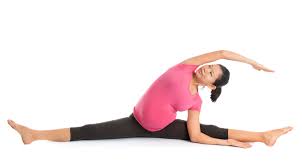
How to do: Sit upright on the ground with the legs apart.
Lift the arms to the side with the elbows flexed & fingers pointing upward.
Use the abdominal muscles & slowly bend sideways to the left, bringing the left elbow towards the floor.
Don’t flex forward or rotate. You can feel the stretch through the obliques.
Hold this abs stretch for 20 to 30 secs, then back to the starting position.
Repeat on the right side & hold for 20 to 30 seconds.
Repeat 2 to 3 times on both sides.
4.Chest opener on an exercise ball:
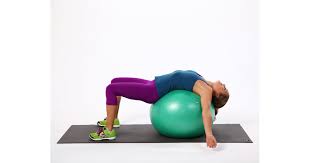
How to do: Take a lying position on the exercise ball.
The scapulae, neck, & head should be on the top of the ball, with the back extended, feet flat on the ground, & knees bent at 90-degrees.
Start the stretch by opening up the arms & letting them drop to the side of the ball.
Make sure you should looking up at the roof.
Hold this stretch for 20-30 secs.
Repeat 3-4 times.
5.Ab Side Stretch:
How to do: Stand tall with the feet shoulder-width apart with the arms on either side.
Raise the left arm in the air, keeping the right arm by the side.
Slowly lean over to the right, sliding the right arm down the side.
In this pose, you should feel a stretch through the obliques.
Slowly back to the original position & place both of the hands on either side.
Repeat the ab stretch, this time raising the right arm in the air.
Pause 8-10 secs per side.
6.Supine Stretch:
How to do: Take a lying position on a mat.
Then lift the arms & reach it over the head with the fingers pointing away from the body.
Stretch by the spine & move away from the head.
Hold this supine stretch for 8 – 10 secs.
7.Slow Cyclone For Abs:
How to do: This is an dynamic ab stretching. Then, stand tall with the feet shoulder width apart & keep a mild bend in the knees to keep them soft.
Stand upright & lift both of the arms in the air.
Circle the torso from the hips upwards so that the trunk moves in a round motion.
As you perform this, keep the arms parallel with the trunk & do the stretch in a continuous motion.
The duration of the stretch is 15 secs.
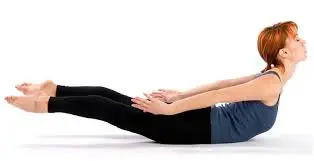
8.Locust Pose:
How to do: Begin by lying in a prone position with the arms at the side, positioned against the side of the legs.
Raise the chest & the legs making a boat shape, so you have an inward curved back.
Release & come back lower to the ground.
Hold this boat pose for 10 secs.
9.Leaning Lifting Crunch:
How to do: Take a standing position shoulder-width apart, & make a prayer pose by holding the palms together.
Lift the arms above the head, imitating the upper half of the tree pose.
Lean over to the right until to feel a stretch in the obliques.
Next, move the torso by leaning to the left, this time kicking the lift leg out to the side at the same time.
Repeat on one side for 20-30 secs then switch to the other side & repeat.
The holding period of this abs stretch is 30 secs on each side, with rest in between.
10.Kneeling Spinal Wave:
How to do: Begin on the hands & knees. obtain the balance & get comfortable on a mat.
Push back so the arms are flat in front of you & the head is lower.
In this pose, you should be seated on the knees with a straight back.
From this position, push up into a ‘cat’ position before returning into a ‘cow’ position
Then, push forward into a cobra pose, with the feet soles upward, legs extended & the chest & torso upright.
Push back into an‘cat’ pose & repeat the motion.
The duration of this stretch is 30 secs.
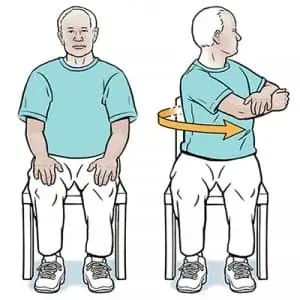
11.Seated Rotation:
How to do: Take a sit on a chair with the spine neutral.
Rotate the body to the right side & pause the position.
Then turn on the left side & pause.
Hold this rotation for 20-30 secs.
12.Bow Pose:
How to do: Begin the stretch by lying on the stomach with the knees together & flexing at a 90-degree angle.
Lift the chest & stomach off the ground while keeping the pelvis & thighs on the ground.
Move the arms backward & grab the ankles as you pull the legs up & push the chest out.
Keep the neck stable with the spine by looking at the wall in front of you during the whole stretch.
Hold this abs stretch for 30 secs & then slow down the upper body & legs to the ground.
13.Twisting Shoulder Bridge:
How to do: Lie supine on a floor.
Bend the both knees & drag the heels towards the hips. The arms by the sides.
Now thrust the hips up towards the sky, the feet touching the ground.
Keeping the left arm on the ground, reach for the left heel.
Then, rolling over onto the left shoulder, reach the right arm back & over the head.
Switch to the other side & repeat.
What are the common mistakes to avoid during the abs stretch?
There are some mistakes you should not do during the abs stretch :
Overstretching: Overstretching during this abdominal stretch could raise the risk of injury & even the pulling a muscle, most likely in the obliques. You have to stretch the muscle enough that you may feel the stretch only & nothing more, but you should stop stretching the muscle as earlier as you feel any pain.
Overarching the back: Overarching the back puts extra stress on the muscles in the trunk, as well as the thighs & hamstrings.
Bending the knees too much: By over bending the knees, you will put extra pressure on the legs, particularly the knees, which could cause pains & aches. Standing in the wrong position could also make the stretch unnecessarily difficult, the amount of time that you can experience it & as a result, make it less effective.
Leaning too far over laterally: Leaning too far during abs stretch causes an increase in the risk of the injuries by giving extra strain to the obliques. Instead of move in an comfortable yet stretching in circular movement.
Going too slow: It was one of the ab stretches that needs to be done at a moderate speed. The crunching action should be a slow & controlled motion as moving too fast would put a strain on the obliques.
Putting the head on the ball: You do not need to overextend the back & have the lower back on the floor as this could cause backache & strain. Instead, assure you have the shoulders & lower back raised onto the ball for optimal support.
Pushing from the toes: Pushing from the toes can be dangerous & give strain to the legs & back.
Moving too quickly: Stretching is slow-motion, & rushing won’t allow you to feel the full advantages of ab workout stretches. So avoid rushing through this movement, take it slow & assure that you feel the muscles stretching.
Bending the knees: In standing abs stretch, You have to stand up with the knees straight when doing this ab stretch. Bending the knees will risk the stretch & ultimately give unnecessary pressure on the legs & knees.
Abdominal strengthening exercise:
Abdominal exercises need to be gradually progressed from how to activate muscles & maintain contraction to integrate them with functional movement.
Health benefits by doing abdominal muscles strengthening exercise:
Helps to supports better posture.
Helps to improve balance.
Helps to support better running form “core strength allows the hips, pelvis & lower back to work together more smoothly with less rocking & less excess energy using.
This exercises improve stability if you have a weak core, you instantly heighten the risk of muscle injuries, lower back pain, & poor posture.
Helps to protects the Organs.
This exercises makes the life easier: like bending down to pick something off from the ground, long time standing or performing household chores. This is the reason why many core exercises fall under the umbrella of functional fitness: They can help you go about the day with more easiness, seriously it makes you more functional.
This exercises can reduced or prevent a low back Pain.
This exercises boosts the power.
This exercise supports strength training.
This exercise helps you age well: It stabilizes the whole body & gives you better balance & posture, all of which can help you prevent falls, prevent back pain, & keep you mobile as you get older.
Helps to improve spine mobility.
However, abdominal exercises can help to tone the belly somewhat by defining the abdominal muscles & once you lose the tummy fat, you will likely to discover that you have that 6 pack hiding underneath.
Many people desire to gain stronger, leaner abdominal muscles (or abs). The abdominal are the muscles surround the tummy & belly button & are often referred to as a “six-pack.” If you are interested in burning belly fat & getting a leaner midsection, here are a,
A few key factors to consider:
Strong abdominal muscles: Focusing on exercises that develop core strength & stability can help develop toned abs.
Genetics: Numerous people are genetically predisposed to abdominal fat. While it doesn’t necessarily mean you will always have it, you may have to step up the workouts to get the results you are hoping to achieve.
Belly fat: You won’t be able to see the strong core muscles from the surface if there is a layer of body fat around you midsection. However, you can still have a strong abdominal & have a bit belly fat & still be considered healthy, especially if you are exercising regularly & following a well-balanced diet.
Types of Exercises to strengthen the abdominal muscles:
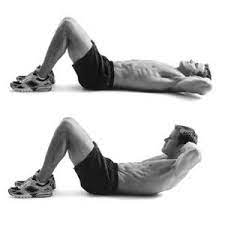
1.Abdominal Crunches:
How to do it:
This is a great exercise to do this will not place too much stress on the lower back & spine.
For this exercise, you have to Lie on your back & flex the knees to a comfortable position, lock the hands behind the head, or cross the arms in front of the chest now curl the head, shoulders, & upper back off the ground.
The lower back should be in contact with the ground; you should only rise a 2 to 3 inches exhale as you rise.
Hold this position for three to five seconds.
Slowly return to the initial position. Repeat 10 more times.
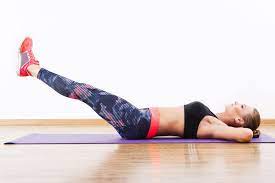
2.Low Ab Leg Raises:
How to do it?
For this exercise, you have to Lie on the back & flex the knees to a comfortable position
Then extend the legs. Contract the abdominal muscles to lift the feet off the ground in an arc-like motion
Lift the feet about ten inches up.Slowly (in the same arc- like motion) return the legs/feet to the ground.
Repeat 10 more times for 2 to 3 set.
3.Twisting Sit-Ups:
How to do it?
This is a great exercise to get the obliques into action & work properly. For this exercise you have to Lie on the back. Flexed the knees to a comfortable position. Lock the hands behind the head.
Curl the head, shoulders, upper & lower back off the floor & angle the left elbow toward the right knee exhale as you lift.
Hold this position for 5 secs .Slowly return to the initial position.
Curl the head, shoulders, upper & lower back off the ground & angle the left elbow toward the right knee .Hold this position for 5 secs.
Again, exhale as you lift slowly return to the starting position .
Repeat 10 more times alternating the twisting motion. Keeping the abdominal ‘s working properly is the best way to stay in shape, & by regularly exercising & maintaining proper posture for the back, you may be able to stave off any attacks of back pain or sciatica.
4.Pilates:
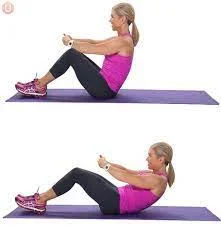
How to it?
Lay on the back & lift the shoulders off the floor while placing the hands next to the hip. Lift the feet up & hold.
Make sure the back touches the floor. If the back bows then raise the legs higher for a rounder back. Keep the legs straight. Hold for 10-20 secs.
5. Bicycle crunch:

How to do it?
This floor exercise is one of the best exercises to strengthen the rectus abdominal muscle.
For this exercise, you have to supine lying on the ground. Press the lower back into the ground & flexed the knees while keeping the feet flat on the ground. Put the hands behind the head, interlacing fingers if preferred.
Elbows wide & gently cradle the head in the hands. Bring the knees up, with shins parallel to the ground, as you lift the shoulder blades off the ground. (Be careful not to strain or pull on the neck.) As you straighten your right leg out at about a 45 degree angle, turn the upper limb to the left, bringing the right elbow toward the left knee. Return to the starting position, with both knees flexed & elbows wide.
Repeat on the other side extend the left leg to a 45 degree angle & turn the upper body to the right, bringing the left elbow toward left knee. Return to the initial position to complete 1 repetition.
Complete 2 to 3 sets of 15–20 repetitions, resting for 30 seconds to 1 minute after each set.
6.Single-Leg Jack Knife:
How to do it?
Lie on your back & stretch the arms above the head. Then lift one leg up & reach the hands toward the foot at the same time.Make sure legs & arms stay straight & your upper body is completely lifted off the floor then slowly lower the body back down to the starting position then switch the legs.
Hold for 10-20 secs. 15–20 repetitions ,2to3 sets each
7.Plank:
How to do it?
Start on your toes & hands or elbows & keep the body straight like a board. Your feet should be hip width apart & the hands or elbows shoulder width.
Hold this position. Make sure the hips is not drop too low or rise too high.
Hold for 20-30 secs.
8.Fitness ball rollout:
How to do it?
Use an exercise ball for this exercise. this exercise targets the rectus abdominal muscle.
To perform the exercise you have to kneel on the ground with a stability ball in front of you or you can use a yoga mat to kneel on for extra cushioning. The ball should be within arm’s reach.
Put the hands in a loose fist & place them on the ball. The forearms will also rest on the ball. Make sure the elbows are flexed up to 90 degrees. Keep the body in a straight line with the back flat. Roll the ball forward with the hands as the arms & body straighten out. This motion needs to be slow & controlled. Keep the gaze looking straight ahead. Extend out as far as you can go. The chest will touch the ball. Hold this position for a 2 to 3 seconds.
Slowly reverse the movement by bending the elbows to roll the ball back to the starting position. Keep your core tight, so the hips don’t drop.
9.Flutter-Kicks:
How to do it?
Lie on your back & place the arms next to the body (straight). Lift both legs & keep them straight while moving them upwards & down the opposite way.
If there is a gap between the floor & the back, raise the upper body to round out the back. You can then lean on the elbow & place them next to the body to hold the weight.
20 seconds or 20 reps, 10 on each side.
10.Sit-ups:
How to do it?
Do sit-ups the right way to keep them safe. Rather than placing the hands behind the head, cross them in front of you or slide them along the thighs to the knee. flexed the knees at a 45 degree angle. For this exercise, you have to Lie on the back with flexed knees & the feet anchored. Tuck the chin towards the chest to lengthen the back of the neck. Interlace the fingers at the base of the skull, cross the arms with the hands on opposite shoulders, or place the palms down alongside your body. Breathe out as you lift the upper limb toward the thighs. Breath in as you slowly lower yourself back down to the ground.
11. Squats:

How to do it?
There have a lot of variations in squatting. Mix them up in the routines to challenge the body in new ways.
For this exercise, you have to stand with shoulder-feet width apart & toes facing front.
Move the hips back—flexed the knees & ankles & press the knees slightly open as you.
Now flexed the knees until the thighs are parallel to the ground.
Press into the heels & straighten the legs to return to the initial upright position.

